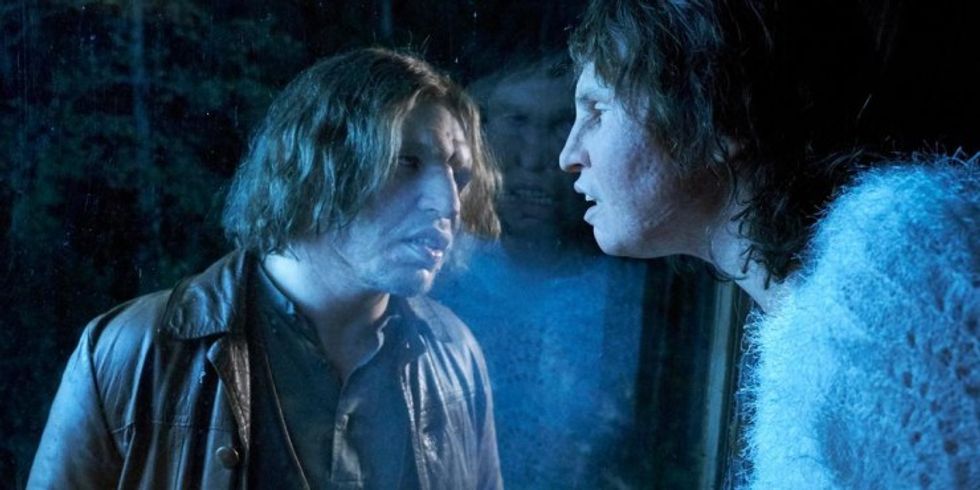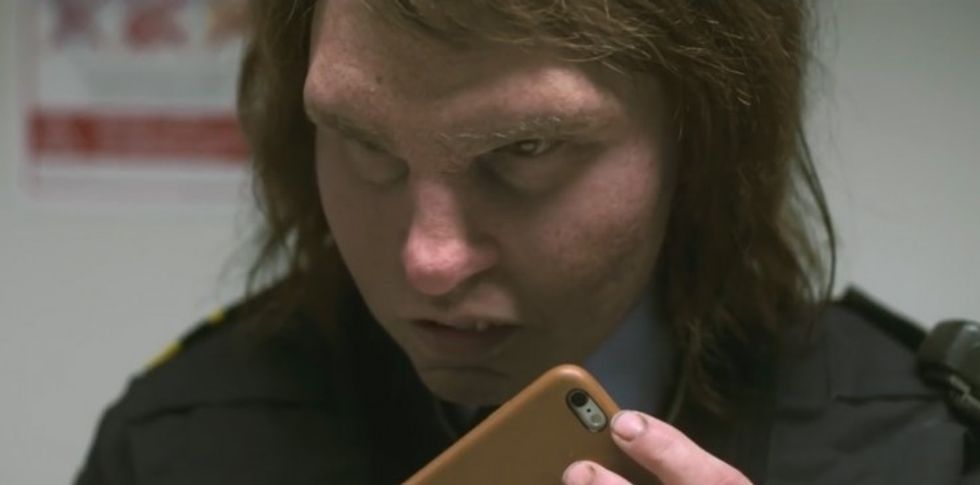'Border' Director Ali Abbasi on Using the Mythology of Fantasy to Pioneer A Story
To make a movie about trolls, 'Border' director Ali Abbasi had to re-invent them.

In one sense, Ali Abbasi's Border is a classic, touching love story. Two misfits meet, fall in love (despite adversity), and then part company. What complicates the story in this film is that the misfits are actually trolls, human trafficking is involved, and one of them keeps a homunculus (more or less) in a fridge.
Border is a relentlessly imaginative film that creeps up and surprises you in the manner of Sakurov or Jeunet and Caro. Tina, played here with care and intelligence by Eva Melander, is a customs inspector who is able, because she is in fact a troll, to smell everything, including evil. She lives in a ramshackle house in the woods with a dodgy young man, half-partner, half-not; she prefers to walk barefoot in the house and in the forest; she has an atypical diet.
One day, Vore (Eero Milonoff), another troll, passes through her inspection and catches her eye; Vore is sweet-natured but he carries the faintest whiff of bad news, which is catnip for Tina. The two fall in love very quickly after Tina invites Vore to stay in a small house behind hers; they have aggressive, loud, guttural, visceral sex; and then things take an odd turn. Vore is not what he seems and our sense of Tina's pain deepens.
The film does a very good job of showing social persecution and, on the flip side, the response to that persecution. Based on a short story by John Ajvide Lindquist, who wrote the remarkable teen vampire story Let the Right One In after his own novel, the film is calm, at odds with the degree to which it asks us to suspend our disbelief, which results in an enticing and often wrenching work.
No Film School talked to Abbasi ahead of the film's release about imagining, or rather re-imagining, trolls.
No Film School: How did you develop the troll characters?
Ali Abbasi: Well, we started thinking about what direction we wanted to go in, and, you know, the references out there are not great. I mean, you have Shrek and you have Trolls and...they weren’t very helpful. We thought, "Okay, we need to find a kind of logic in this," and I started thinking, "What is the whole mythology of trolls?" They look dangerous, and they steal our children, but at the same time they look close enough to us to be human. Neanderthals were also like us, like homo sapiens. We fought them and made them extinct by winning the survival race, and we made a myth out of how dangerous they were. I thought "Okay, what if they looked like neanderthals?" That was our starting point, and then Goran Lundstrom, who designed the masks, took it many notches up.
NFS: The trolls move differently than the other characters in the film, and I was wondering how that developed...
Abbasi: Well, I wanted them to have a certain clumsiness, as if they had tried to fit in within our human society but failed to do so, so they are uncomfortable sitting on chairs or walking through a door. I also asked the actors to gain weight, because I thought that would make you a bit more clumsy, because you feel heavier, not as fast. I think Ava, for instance, gained 40 pounds or something and that really changed their movements. Of course, I think the actors were also very careful with the way they executed it and the way they thought about it, but I also think that having a real physical limitation like that weight dictates some of the movement.
NFS: When you were getting the actors into character for the film, was there an orientation period, where they became familiar with the idea of playing these trolls?
Abbasi: Well, they were doing some work at the gym because they needed to build up their strength, but that was very basic. As we were working, Eva and Eero had their own routine. Generally, I would g,ive them a lot of freedom, and I also would give them a lot of responsibilities. But I didn't necessarily prepare with them.
Of course, we did a lot of things, but that wasn't something we did necessarily together, if that makes sense. We also knew what kind of things we needed to do, so they had their own homework, so to speak.
NFS: I read that you took a very long time to find Eva for this particular part, and I'm wondering what qualities you were looking for in that character...
Abbasi: It almost took two years to find Eva. One reason for that was due to the kind of actor I was looking for and another was that I use casting as a creative tool. As I was seeing different Tinas, I was thinking, "Okay, so is this the Tina in the movie?" By the time I met Eva, I think I had this general feeling that I had to find a character actor. If you have, say, Nicole Kidman or Tom Cruise, they have a certain psychology, a certain way of behaving. You don't go to a Tom Cruise movie to not see Tom Cruise, you go to see him in different shades of Tom Cruise. I wanted somebody who could lose themselves completely in the transformation.
I think that's something character actors are very good at. Another thing is that Eva gets an impulse and she lets that impulse to do something with her. She does it very honestly, without necessarily knowing where that impulse will take her. Sometimes she would laugh, sometimes she would cry, sometimes she would blush, but it was always very honest. And I thought that was exactly what I needed with a person whose face is going to be 95% covered—otherwise you get this kind of stiffness because you’ve already decided everything.
"I use casting as a creative tool."
NFS: How did you find and develop the location for Tina’s house, where much of the film takes place?
Abbasi: Before I started making movies, I studied architecture. I'm very sensitive about the spatial quality of movies. I wouldn't just think about a location like a house, I would think that the house has to have certain qualities and has to be precisely what I'm looking for. This means that the search drags on and on and on and it's sometimes really difficult.
Locations are, after actors, the most important and most difficult thing to usually find. With that house, we were looking for months, and then one day I got up, one month or maybe one half-month from shooting, and I thought, "Look, either we find this house or we postpone the shoot." Strangely enough, when we decided we weren't going to compromise on anything, we actually found it. And then of course, you see one thing in the movie and then another thing is in reality. The reality is kind of a framework, but that's not necessarily what we show in the movie.
For example, the forest around the house is not necessarily the forest that's around the house, it's six different locations stitched to one. But I think the fact that this house has the qualities it has and has the surroundings it has make everything believable.
"When you do a movie about an outsider, about a character who is the other, you see the world with their eyes. That is in itself a kind of political decision."
NFS: What qualities of the house drew you specifically?
Abbasi: Well, it's like an ugly house in very beautiful surroundings. All of us thought that if Tina lived in civilization, she wouldn't have a fancy house because she wouldn't care about that, because that's not where her real home is, so to speak. And then, everything felt a little bit small, which made sense because it would amplify their sense of being clumsy and having difficulty making elegant movements. I think it was also important that it's not a house that is made of concrete or brick, even, because I thought if these people or these characters are living in a house, it should be made of the same wood as in the forest around them.
NFS: There is quite a large social and political dimension to the film, and I'm wondering to what extent that was relevant when you were working with the actors and (before that) developing the script.
Abbasi: I think if that aspect is within the story, you can always play with it, let it live. I think it would get the message across. When you do a movie about an outsider, about a character who is the Other, you see the world with their eyes. That is in itself a kind of political decision, not maybe in the sense of politics, but in the sense of who's in power, who's normal, what’s the status quo, etc. You then turn it on its head.
"Locations for me are, after actors, the most important and the most difficult thing to find, usually."
NFS: One thing that was very interesting to me about this film is that in Scandinavian culture, things like trolls or goblins or faeries are a little bit more significant than they are in some other cultures, and I'm wondering to what extent that was an element in the performances of the film itself?
Abbasi: To be totally honest with you, I am not an expert on troll mythology at all. I read the short story and then I talked to the author and then I added some elements. This mythology is not very well established, like zombies or vampires, with a procedure or backstory, which makes it good for inventing stuff.
I thought "Okay, I'm an outsider, I don't know much about this mythology, and maybe that is an advantage." Instead of trying to get to know everything about it, I just said, "Maybe I should say these are just nonhumans." I could then define the way in which they are nonhumans myself and then give them the shell of being trolls. But that’s just to say that I wasn't very occupied with the impact of mythology, because we were inventing the mythology. We're like the pioneers of troll movies.















